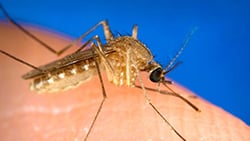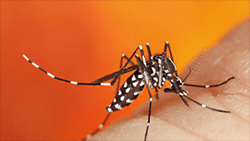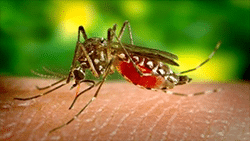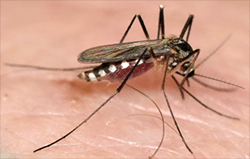Alabama is home to over 60 species of mosquitoes. Here are the four most common.
 Southern House Mosquito (Culex quinquefasciatus) is a medium-sized brown mosquito that makes its home in the southern United States and is present throughout Alabama. This nighttime-active, opportunistic blood feeder is a vector of many pathogens such as West Nile Virus, St. Louis Encephalitis, and Western Equine Encephalitis.
Southern House Mosquito (Culex quinquefasciatus) is a medium-sized brown mosquito that makes its home in the southern United States and is present throughout Alabama. This nighttime-active, opportunistic blood feeder is a vector of many pathogens such as West Nile Virus, St. Louis Encephalitis, and Western Equine Encephalitis.
Females fly during the night to nutrient-rich standing water where they will lay their eggs. They will oviposit in waters ranging from wastewater areas to bird baths, old tires, or any container that holds water.
 Asian Tiger Mosquito (Aedes albopictus) The Asian tiger mosquito was first documented in the United States in Texas in 1985, this species has spread rapidly throughout the eastern states, including all of Alabama’s 67 counties.
Asian Tiger Mosquito (Aedes albopictus) The Asian tiger mosquito was first documented in the United States in Texas in 1985, this species has spread rapidly throughout the eastern states, including all of Alabama’s 67 counties.
The Asian Tiger Mosquito is a vector of more than 30 viruses including dengue fever, St. Louis and LaCrosse Encephalitis, Cache Valley Virus, and Eastern equine encephalitis virus.
Its life cycle is closely associated with human habitat, and it breeds in containers with standing water, often tires or other containers. It is a daytime feeder preferring the early morning and late afternoon. It can be found in shady areas where it rests in shrubs near the ground.
The Asian Tiger Mosquito egg enters diapause to survive winter. Standing water is not needed to lay eggs. Eggs are laid singly on the sides of water-holding containers such as tires, animal watering dishes, birdbaths, flowerpots, and natural holes in vegetation. Eggs hatch after rainfall raises the water level in the containers.
 Yellow Fever Mosquito (Aedes aegypti) has been a nuisance species in the United States for centuries. Originating in Africa, it was most likely brought to the new world on ships used for European exploration and colonization.
Yellow Fever Mosquito (Aedes aegypti) has been a nuisance species in the United States for centuries. Originating in Africa, it was most likely brought to the new world on ships used for European exploration and colonization.
As the common name suggests, this mosquito is the primary vector of yellow fever, a disease that often emerges in temperate regions during the summer months. During the Spanish-American War, U.S. troops suffered more casualties from yellow fever transmitted by Aedes aegypti than from enemy fire.
Yellow fever mosquitoes are container-inhabiting mosquitoes; often breeding in unused flowerpots, spare tires, untreated swimming pools, and drainage ditches. They thrive in urbanized areas, in close contact with people making them an exceptionally successful vector of viruses.
Male and female adults feed on nectar of plants; however, females blood feed primarily on humans to produce eggs and are active in the daytime.
Eggs can survive without water for long periods of time, allowing them to survive winter months and drought while easily spreading to new locations.
 Eastern Treehole Mosquito (Ochlerotatus triseriatus) is found in the eastern half of the US, including Alabama. It normally lays its eggs in pools of water accumulated in tree holes, but it will also lay eggs in man-made water-holding containers, particularly discarded tires.
Eastern Treehole Mosquito (Ochlerotatus triseriatus) is found in the eastern half of the US, including Alabama. It normally lays its eggs in pools of water accumulated in tree holes, but it will also lay eggs in man-made water-holding containers, particularly discarded tires.
They reproduce most frequently in natural or suburban forested areas and overwinter as eggs located in dry nesting sites that become flooded in spring.
The Eastern Treehole Mosquito most often feeds on rodents but will also take a blood meal from humans. Feeding activity is largely at twilight. They are the primary vector of La Crosse virus but also transmit numerous other viral ailments.
